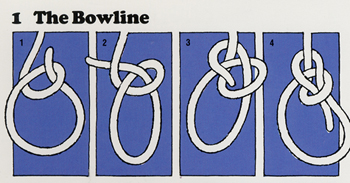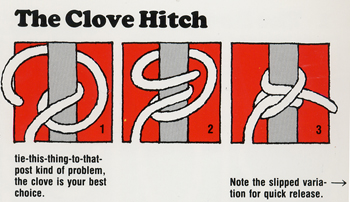The Klutz Book of Knots
Mastering the few knots you need
You can triumph in 99% of life’s challenges knowing how to tie 6 basic knots — which is probably 4 more knots than you currently know. The thing about knots is that a few will do if you really own them. Forget about those 300 ingenious knots sailors use, and for now master the few versatile ties taught in this cleverly engineered book. I own most of the knot books, and this is the best one for learning the ropes. It’s for klutzes.
Volunteer to teach a boy/girl scout troop using this book; you’ll learn fast.
09/10/18Excerpt

The Bowline
If you were marooned on a desert island and could only take one knot with you, this would be the one. Properly tied in ordinary rope, there is little danger of the bowline slipping before the breaking point of the rope itself is reached -- a comforting thought if you should ever have to tie a rope around your waist. And nearly as important, the bowline is easy to untie, even after having been dunked in water and put under load. Like most knots, the bowlin's origins were on board the full-rigged sailing ships where it was used almost to the exclusion of all other loop knots, and where it was said that "the devil himself would make a good sailor, if he could only tie a bowline and look aloft."
If you should ever have to deal with particularly thick or stiff materials -- a rolled up bedspread for example, or anything cable-like one of the best ways to joint them is with two interlocking bowlines.
*

The Clove Hitch
My favorite nearly-all-purpose hitch. Simple to tie, simple to untie, and won't jam under strain. There are better hitches if you're especially concerned about security, and if you're attaching a rope to a square shape -- like a piece of lumber -- the clove is not appropriate, but for your run-of-the-mill, tie-this-thing-to-that-post kind of problem, the clove is your best choice.
(This is a Cool Tools Favorite from 2003 — editors)
John Cassidy 1985, 24 pages Out of print, but used copies are available for $1.50 and up









